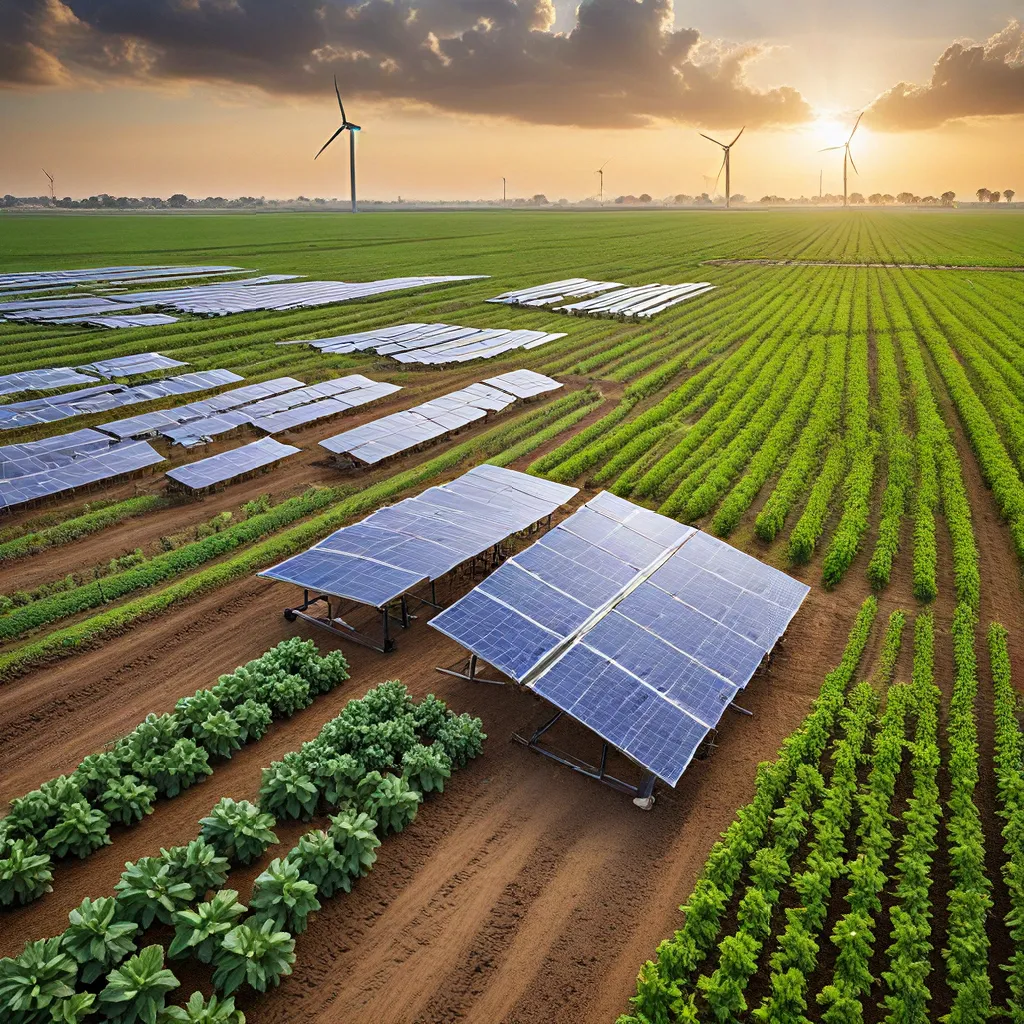
The Sun-Kissed Duo: Solar and Crops, a Match Made in Heaven
Picture this: a sprawling farm, dotted with rows of sleek, gleaming solar panels stretching as far as the eye can see. But wait, there’s more – nestled beneath those solar arrays are thriving crops, basking in the filtered sunlight and reaping the benefits of this revolutionary agricultural technique. Welcome to the world of agrivoltaics, where renewable energy and sustainable agriculture have joined forces to create a truly symbiotic relationship.
As someone who’s always been fascinated by the intersection of technology and nature, I’ve been keeping a close eye on this emerging field. And let me tell you, the more I learn about it, the more excited I am about the incredible potential it holds for transforming the way we approach food and energy production.
The Thirsty Dilemma: Quenching Agriculture’s Insatiable Appetite
You see, agriculture is a thirsty beast. In fact, it accounts for a staggering 85% of global water consumption, and that’s just for irrigation. And let’s not forget about the energy required to power all the machinery, equipment, and infrastructure needed to keep our farms running. In fact, over one-third of all greenhouse gas emissions can be attributed to the agricultural sector.
Now, with the global population expected to reach a whopping 9.8 billion by 2050, the demand for food is only going to skyrocket. We’re going to need to nearly double our current food production just to keep up. But here’s the kicker – with the current state of affairs, we simply won’t have enough water or energy to make that happen. It’s a recipe for disaster, my friends.
Powering the Future: Harnessing the Sun’s Potential
But what if I told you that there’s a way to solve this crisis, and it all starts with the sun? Renewable energy has been touted as the solution to our energy woes, and it’s time to take that one step further by integrating it directly into our agricultural systems.
Enter agrivoltaics, the revolutionary concept that combines solar energy generation with crop production on the same land. It’s a win-win-win situation, my friends. Not only does it help us meet our renewable energy targets, but it also reduces water usage and creates a more sustainable long-term food system. Talk about a triple threat!
The Symbiotic Dance: How Solar and Crops Empower Each Other
Here’s the thing – plants have a limit to how much sun they can actually use. It’s called the light saturation point, and once it’s reached, any additional sunlight doesn’t actually help the plant grow. In fact, it just makes the plant “sweat,” which in turn makes it more thirsty.
But that’s where the solar panels come in. By strategically positioning them above the crops, they can provide just the right amount of sunlight, while the excess is harvested for electricity. And get this – the plants actually help keep the solar panels cool, which in turn boosts their productivity by up to 10%! It’s a match made in heaven, I tell you.
Farming the Future: Agrivoltaics in Action
Now, you might be wondering, “Okay, this all sounds great in theory, but how does it work in practice?” Well, let me tell you about the innovative project happening right here in my own backyard, at the Oregon State University’s North Willamette Research and Extension Center.
They’ve set up a five-acre model agrivoltaic system that’s expected to be fully functional by the fall of 2021. And get this – the current projections estimate that if we were to convert just 1% of American farmland to agrivoltaics, it would meet our national renewable energy targets and save a ton of water in the process. Not to mention, it would create new revenue opportunities for family farms, which are facing increasing economic challenges.
According to the experts at OSU, the initial investment required to convert 1% of American farmland to agrivoltaics would be around 1% of the federal budget. But get this – the energy savings would pay for that investment within just 14 years. Talk about a smart long-term investment, am I right?
Cultivating a Sustainable Future: The Power of Systems Thinking
Now, I know what you’re thinking: “This all sounds too good to be true. There must be a catch.” Well, my friends, the beauty of agrivoltaics lies in its systems-thinking approach. It’s not just about solving one problem; it’s about addressing the intertwined issues of long-term sustainable farming, energy production, and water conservation all at once.
By harnessing the power of the sun and integrating it seamlessly into our agricultural systems, we’re not only creating a more efficient and sustainable food system, but we’re also paving the way for a cleaner, more energy-independent future. And let’s not forget the added bonus of supporting our rural communities and family farms in the process.
So, what are we waiting for? It’s time to embrace the sun-kissed duo of renewable energy and sustainable agriculture, and watch as they dance their way into a brighter, more prosperous future. Who knows, maybe one day we’ll all be sipping on solar-powered smoothies, grown right here in our own backyard farms. The possibilities are endless, my friends, and I for one, can’t wait to see what the future holds.